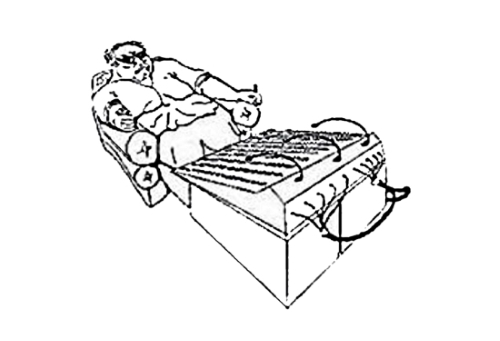Somebody has been feeding misinformation to our pal Roy here.
He wrote in twice and I have taken the liberty of mixing and matching excerpts from both his missives.
Good Sir –
Yes, Roy!
I was hoping you would grace us with your suggestions on miking guitar amps, placement and such.
When you go to concerts, do you ever see the taped “X” on some poser’s 4 x 12 cabinet? Either he or his guitar tech has painstakingly determined that this is the single best-sounding speaker in the box.
They’re absolutely convinced that—after combining his input with the 115 dB conniption fit that the bass player is having, along with the distorto-spazz attack that the other guitarist is experiencing on his brand-spanking-new seven-string Korn/Official Slipknot ax from Guitar Center, plus the wild flailing of the drummer on his chrome double-kick kit with 14 cymbals, topped by the bestial howling of the pseduo-satanic singer—every person in the audience will nod their heads knowingly and say: “I’m sure glad they didn’t mic one of those other twelves!”
Whew!
Personally, I put the mic on the edge of the speaker, about 2 inches off the cab. When it’s a 4 x 12, I use one of the upper speakers—unlike my colleagues, who seem to really love that wave of 150 Hz that rolls around the stage about a foot off the ground. I encourage players with smaller amps to put them up on a case lid or a chair to get it out of that hell-stream.
As well, is it true that compressors are only triggered by low frequencies?
No, that is an urban myth. Perhaps you were misled by the true fact that it takes more amp power to push subwoofers than high-frequency loudspeakers.
An Old Soundman trick is to knock down 25 and 31 on your graphic EQ at front of house. That way, the amp is not struggling to reproduce those frequencies, which are not important in 99.99 percent of today’s popular music.
Of course, the gang in the Live Audio Board will say that by doing so you’re totally warping your phase response.
Don’t listen to them, Roy!
Also, what are the pros and cons of miking/DI-ing bass amps?
The DI brings the sound to you without any of the ambient noise onstage being included. It can seem kind of dry, though.
The mic brings you the sound of the speakers (the tone of which the player allegedly enjoys.) However, it can also pick up a lot of the crap noise swirling around in general.
Generally, I first put up the DI and then add some mic around the edges for fatness.
And finally, the band my bar is hosting this weekend has a stand-up bass, and it sounds awesome!
Thanks,
Roy
Perhaps you’re unaware how seldom that is the case with upright basses—or maybe you are, and that’s why you used the exclamation mark.
Luv –
The Old Soundman
There’s simply no denying the love from The Old Soundman. Check out more from OSM here.




















